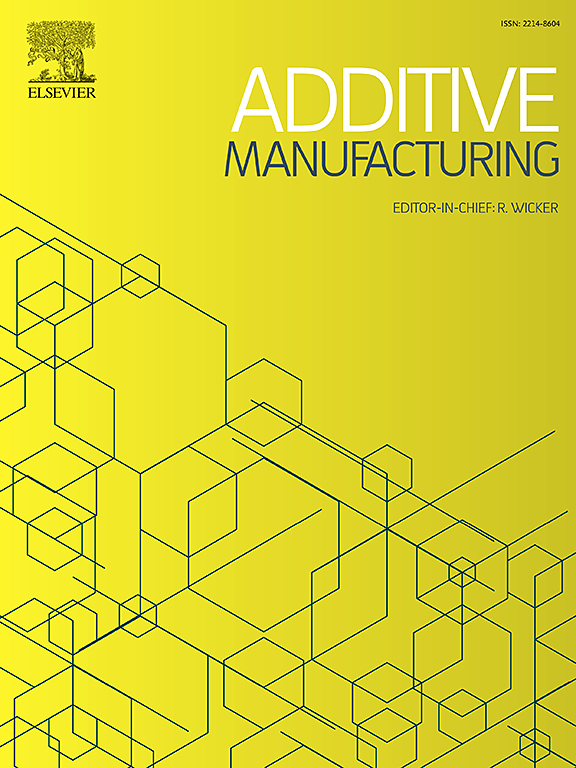X-ray computed tomography investigation on the geopolymer matrix formation during the binder jetting additive manufacturing process
IF 10.3
1区 工程技术
Q1 ENGINEERING, MANUFACTURING
引用次数: 0
Abstract
This study investigates the geopolymerization mechanism in a binder jetting additive manufacturing system, where a highly alkaline solution is deposited onto a powder bed comprising sand and metakaolin. Two individual alkaline solutions, sodium- and potassium-based, were systematically compared, along with tap water, to interpret processes governing the formation of the geopolymer gel and the subsequent hardening of printed components. Nondestructive volume analysis via X-ray computed tomography was employed to characterize the multiscale structure of the powder bed, while real-time monitoring of alkaline solution–powder bed interactions provided insights into the reaction kinetics as well as material consolidation, from droplet impact to formation of the geopolymer matrix. The results demonstrate successful activation of metakaolin without mechanical mixing, achieved using a large-scale 3D printer with a voxel resolution of 3.0 × 3.0 × 3.0 mm³ , facilitating the production of large-volume geopolymer components, with an appropriate compressive strength of ∼20 MPa, suitable for structural applications. Moreover, Nuclear Magnetic Resonance (NMR) spectroscopy proved the change in the coordination states of aluminium ions, shifting from mixed four-, five-, and six-coordination in metakaolin to predominantly tetrahedral coordination in the final geopolymer. These findings provide critical insights into the microstructural evolution and reaction mechanisms in binder jetting-based geopolymerization.
粘结剂喷射增材制造过程中地聚合物基质形成的x射线计算机断层扫描研究
本研究研究了粘合剂喷射增材制造系统中的地聚合机制,在该系统中,高碱性溶液沉积在由沙子和偏高岭土组成的粉末床上。两种单独的碱性溶液,钠基和钾基,与自来水进行了系统的比较,以解释控制地聚合物凝胶形成的过程和随后的打印组件硬化。通过x射线计算机断层扫描进行的非破坏性体积分析用于表征粉末床的多尺度结构,而碱性溶液-粉末床相互作用的实时监测提供了从液滴撞击到地聚合物基质形成的反应动力学和材料固结的见解。结果表明,利用体素分辨率为3.0 × 3.0 × 3.0 mm³ 的大型3D打印机,在没有机械混合的情况下成功激活了偏高岭土,促进了大体积地聚合物组件的生产,抗压强度为~ 20 MPa,适合于结构应用。此外,核磁共振(NMR)谱证实了铝离子的配位态发生了变化,从偏高岭土中的混合四、五、六配位转变为最终地聚合物中主要的四面体配位。这些发现为粘合剂喷射型地聚合的微观结构演变和反应机制提供了重要的见解。
本文章由计算机程序翻译,如有差异,请以英文原文为准。
求助全文
约1分钟内获得全文
求助全文
来源期刊

Additive manufacturing
Materials Science-General Materials Science
CiteScore
19.80
自引率
12.70%
发文量
648
审稿时长
35 days
期刊介绍:
Additive Manufacturing stands as a peer-reviewed journal dedicated to delivering high-quality research papers and reviews in the field of additive manufacturing, serving both academia and industry leaders. The journal's objective is to recognize the innovative essence of additive manufacturing and its diverse applications, providing a comprehensive overview of current developments and future prospects.
The transformative potential of additive manufacturing technologies in product design and manufacturing is poised to disrupt traditional approaches. In response to this paradigm shift, a distinctive and comprehensive publication outlet was essential. Additive Manufacturing fulfills this need, offering a platform for engineers, materials scientists, and practitioners across academia and various industries to document and share innovations in these evolving technologies.
 求助内容:
求助内容: 应助结果提醒方式:
应助结果提醒方式:


